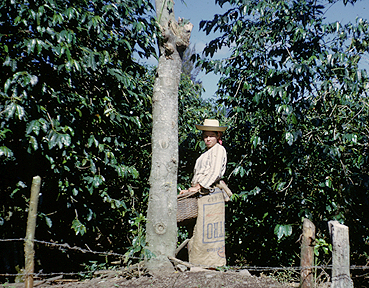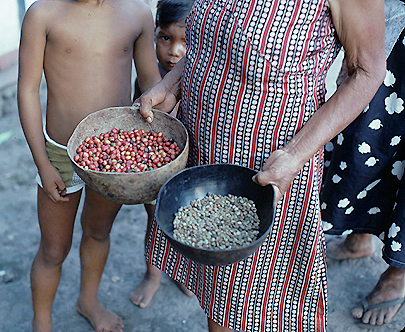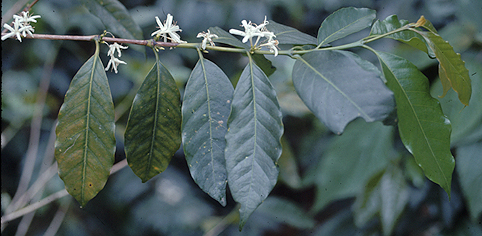Rubiaceae of the New World
By Piero Delprete and
Rocio Cortés
COFFEA Linnaeus
Rubiaceae of the New World
By Piero Delprete and
Rocio Cortés
COFFEA Linnaeus
 |
 |
 Freshly harvested coffee
fruits and recently roasted beans Freshly harvested coffee
fruits and recently roasted beans
Bahia, Brazil Photo S. Mori |
 Flowering branch of Coffea
Photo P. Delprete Flowering branch of Coffea
Photo P. Delprete
Serra da Meruoca, State of Ceará, Brazil |
Subshrubs, shrubs or small trees; raphides absent; axillary thorns absent. Stipules interpetiolar, free or connate at base, deltoid, persistent. Leaves opposite or whorled, 3 or 4 per node, long- to short-petiolate; blades elliptic, oblong-elliptic or elliptic-obovate, carthaceous to thinly coriaceous; foliar pellucid glands absent; domatia dense tufts of hair, pits, or absent. Inflorescence axillary, fasciculate, pauciflorous. Flowers bisexual, protandrous. Calyx cup-shaped, with small lobes or truncate, persistent; lobes usually 5, broadly triangular or broadly ovate, minute. Calycophylls absent. Corolla hypocrateriform or narrowly infundibuliform, actinomorphic; white to cream-white, pinckish-white to pinck; tube externally glabrous, internally glabrous or villous, without a pubescent ring inside; orifice annular thickening absent; lobes 4 to 8, contorted, oblong, elliptic or ovate, margin entire, rounded or acute at apex. Stamens alternate to the corolla lobes, included, partially or totally exserted; anthers narrowly elliptic or narrowly oblong, round at base, round at apex, dehiscing by longitudinal slits, dorsifixed near the base; filaments attached at middle of the corolla tube, free at base, filiform, short (anthers subsessil) or long, shorter than corolla tube, equal, glabrous throughout or puberulent at basal portion (glabrous above). Pollen colporate, apertures 3 or 4, exine surface reticulate, released as monads. Style exserted just beyond or well beyond the corolla, filiform or terete, not fleshy, glabrous; lobes 2, linear to subulate. Ovary inferior, 2-locular, ovoid, obovoid or globose; placentation axile, placenta reduced, ovules medially inserted, 1 per locule. Fruits drupaceous, fleshy. Seeds vertical, medium-sized, dorsally convex, ventrally sulcate; wings absent.
Geographic distribution: A genus of about 50 species, most of them native of the African continent, and a few endemic to Madagascar and the Indian Ocean.
Number of species: About 8 species cultivated in the neotropics. Coffea arabica, C. liberica, C. robusta and C. canephora are the most common cultivated species, which are sometimes found in the neotropics as escapes or sometimes naturalized.
References: The literature of Coffea is vast, a recent
overview of all aspects of Coffea has been recently edited by Robbrecht
(Kawa, Les secrets du café, du caféier à la tasse,
Jardin Botanique National du Belgique, CIP Bibliothèque Royale Albert
I, Bruxelles, 1995. 128 pp.).